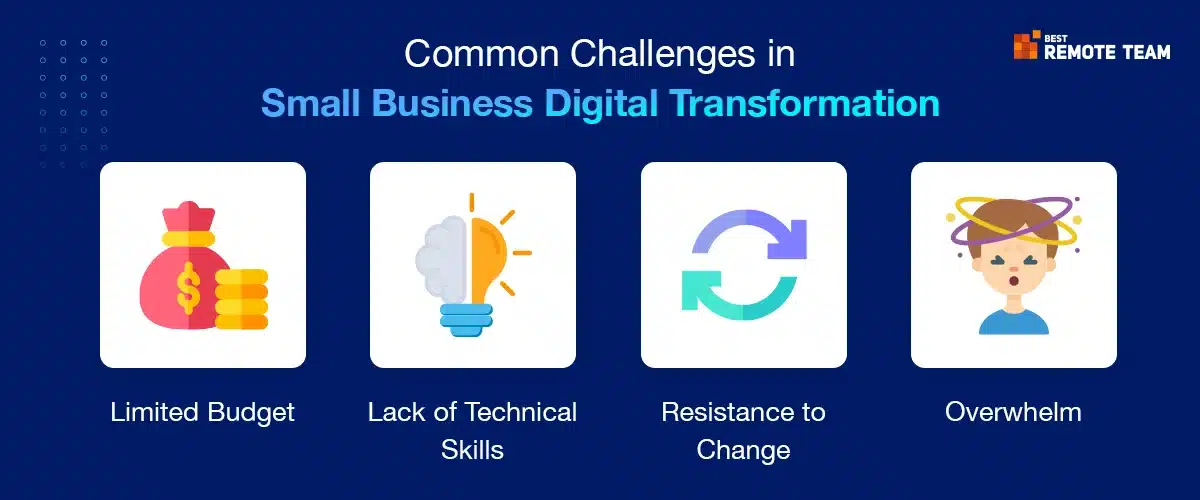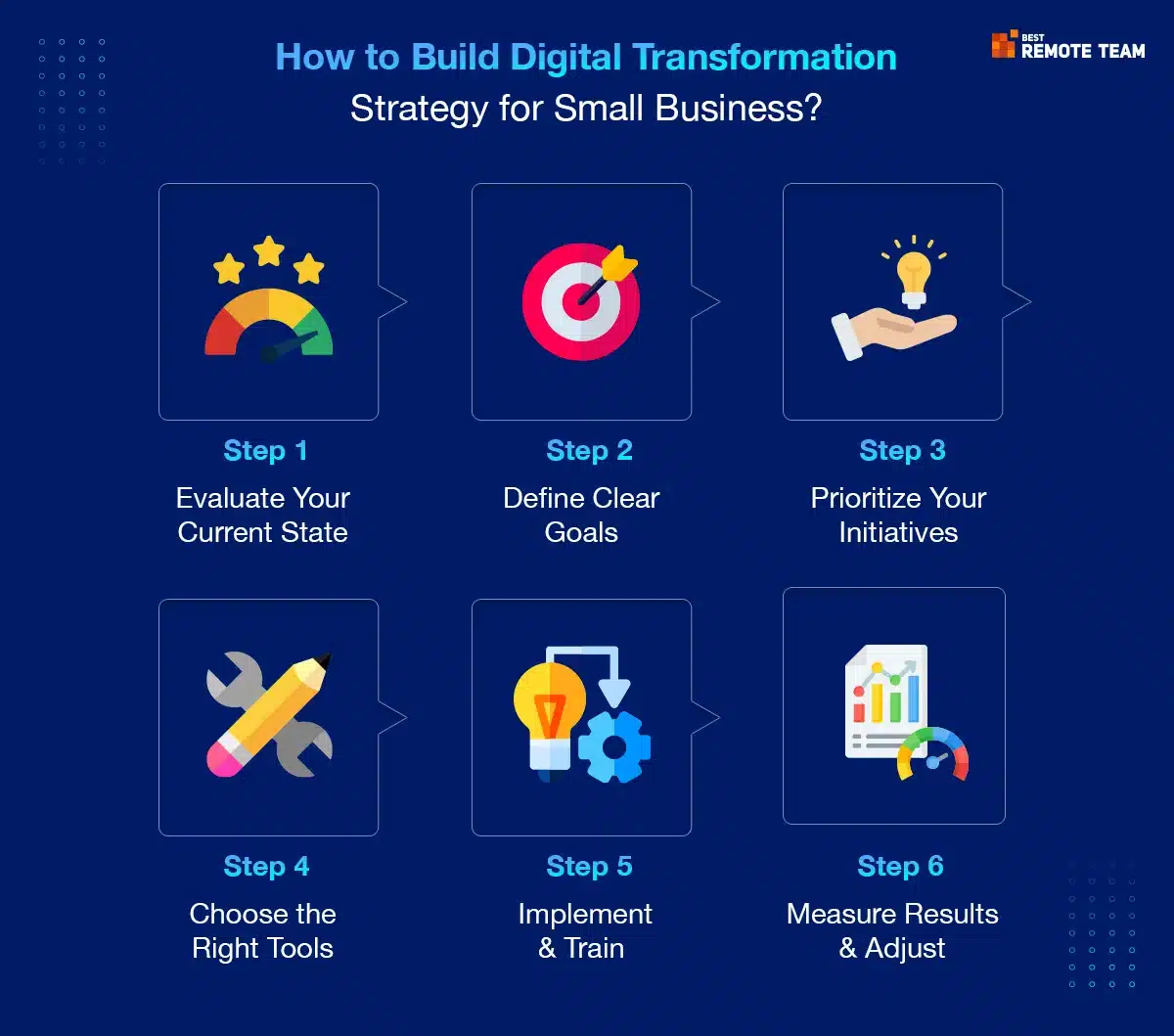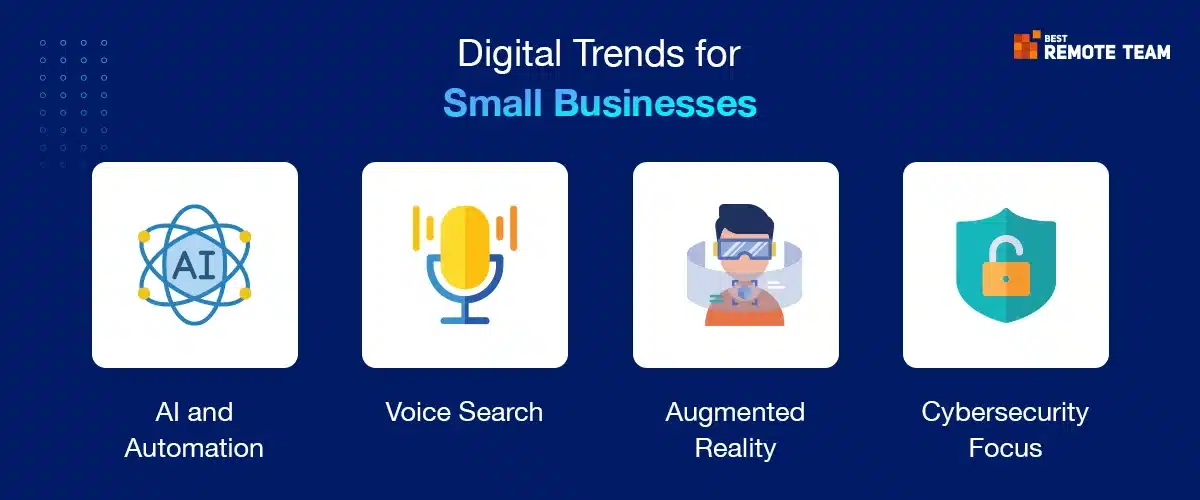Digital Transformation Statistics
- 61% of business executives see digital transformation as a major focus in their companies. -(westmonroe)
- 81% of business leaders say investing in digital transformation is crucial for success. -(valtech)
- 74% of organizations consider digital transformation a key technology effort. -(flexera)
- 56% of US executives say the returns from digital transformation have been better than expected. -(kpmg)
- 58% of organizations plan to increase their digital transformation budget this year. -(valtech)
- 89% of C-level executives say their company has worked on at least one major digital transformation project in the past two years. -(mckinsey)
What is Digital Transformation?
Simply put, digital transformation for small businesses means using technology to change how your business operates and delivers value to customers. The process goes far beyond purchasing new computers or website creation. Your business needs to develop a completely new operational framework that uses digital tools as its core foundation.
The process resembles moving from traditional paper maps to modern GPS navigation systems. While both methods lead you to your destination, digital navigation provides live traffic information and multiple route options and traffic jam avoidance.
For small businesses, digital transformation might include:
- Moving From Paper Records To Digital Databases
- Accepting Online Payments Instead Of Just Cash Or Checks
- Using Social Media To Connect With Customers
- Automating Repetitive Tasks With Software
The beauty of digital transformation for small businesses is that you don’t need to change everything at once. Your digital capabilities can gradually build from their initial foundation.
Why Does Digital Transformation Matter?
Small business digital transformation has moved from being optional to necessary. The following reasons demonstrate why this concept has become crucial at the present time:
#1. Customer Expectations Have Changed
Today’s customers expect convenience. They want to:
- Find Your Business Online
- Browse Your Products Or Services From Their Phones
- Book Appointments Without Calling
- Pay Digitally
- Receive Quick Responses To Questions
Customers normally prefer businesses that fulfil their digital expectations. So they can choose your competitors over you if your small business may not be able to match those standards.
#2. Competitive Advantage
Digital tools create opportunities for balanced competition. A business with strategic digital approaches can successfully compete with much larger competitors. An online store operated by your local bookshop enables it to serve customers from around the world in the same way that Amazon does.
#3. Efficiency and Cost Savings
Digital transformation for small businesses often leads to significant cost savings. The automation of regular tasks creates time availability, which allows you to dedicate efforts toward business expansion. Digital tools can help you:
- Reduce Paperwork
- Minimize Errors
- Speed Up Processes
- Lower operational costs
#4. Data-Driven Decisions
Digital tools enable you to obtain important data about your customers and operations. The collected information enables you to make informed business decisions through factual evidence instead of relying on assumptions.
Common Challenges in Small Business Digital Transformation
We need to resolve several typical obstacles before moving forward with strategies.
#1. Limited Budget
Small business owners frequently express concern about spending money on digital transformation initiatives. Numerous digital tools begin with either free access or affordable starting costs. Cloud-based solutions enable businesses to use their resources through flexible payment systems that expand with business growth.
#2. Lack of Technical Skills
You don’t need to be a tech expert to implement digital transformation for small businesses. Modern technology tools come with interfaces that most users can understand without advanced training. Plus, there are resources available to help you learn, including online tutorials, community classes, and digital transformation services for small businesses.
#3. Resistance to Change
Change can be uncomfortable. Your team members show hesitation toward adopting new systems and different working methods. The implementation of this solution needs both clear benefit explanations and proper training sessions.
#4. Overwhelm
Digital platforms have become so popular that many people experience overwhelming feelings. The key is to start with a clear digital transformation strategy for small business that focuses on your most pressing needs first.
Building Your Digital Transformation Strategy for Small Businesses
A digital transformation initiative succeeds only through strategic planning. Here’s how to create one:
Step 1: Evaluate Your Current State
Your first step should be to establish your current position before starting any modifications.
- What Digital Tools Are You Already Using?
- Which Business Processes Are Manual Or Inefficient?
- What Are Your Biggest Operational Challenges?
- How Do Customers Currently Interact With Your Business?
The audit process reveals which areas digital transformation should be focused on.
Step 2: Define Clear Goals
What are your main objectives for digital transformation? Common goals include:
- Increasing Online Sales
- Improving Customer Service
- Reducing Operational Costs
- Expanding To New Markets
- Streamlining Workflows
Be specific about what success looks like for your small business digital transformation.
Step 3: Prioritize Your Initiatives
The process of change requires multiple steps at different times. Organize your digital initiatives into ranked order according to:
- Potential Impact On Your Business
- Urgency Of The Need
- Cost And Complexity To Implement
- Available Resources
Begin with fast-returning changes which deliver major benefits while requiring minimal effort.
Step 4: Choose the Right Tools
After defining your priorities, you should investigate tools that fulfil your particular requirements. Consider:
- Ease Of Use
- Integration With Your Existing Systems
- Scalability As Your Business Grows
- Customer Support And Training
- Total Cost Of Ownership (Not Just Purchase Price)
For small businesses, Digital transformation service providers often start with these fundamental tools:
#1. Customer Relationship Management (CRM) System
A CRM system offers you to monitor customer interactions and control sales pipelines while enhancing service quality. Small businesses can start with free starter plans from providers such as HubSpot and Zoho.
#2. Cloud-Based Productivity Tools
The essential tools for modern workplace operations such as email, document collaboration, storage, and video conferencing are available through services like Google Workspace and Microsoft 365.
#3. Payment Processing Solutions
Small businesses can easily process digital payments through Square and PayPal as well as Stripe both in person and online.
#4. Social Media Management Platforms
Buffer and Hootsuite enable businesses to maintain active social media profiles without dedicating all their daily time to platform management.
#5. Website and E-commerce Platforms
The website development platforms Shopify, Wix, and WordPress provide users with simple tools to build professional online platforms regardless of their current website situation.
Step 5: Implement and Train
Once you’ve selected your tools, create an implementation plan:
- Start With One Tool Or Process At A Time
- Provide Adequate Training For Yourself And Your Team
- Document New Procedures
- Set Realistic Timelines For Adoption
Remember that digital transformation for small businesses is a journey, not an overnight change.
Step 6: Measure Results and Adjust
After implementation, track your progress:
- Are You Achieving The Goals You Set?
- Have You Encountered Unexpected Challenges?
- Do You Need To Adjust Your Approach?
Be prepared to make changes based on what you learn.
Key Areas of Digital Transformation for Small Businesses
Now, let’s explore specific areas where digital transformation can have the biggest impact:
#1. Customer Experience Transformation
Today’s customers expect seamless experiences across all touchpoints with your business. Consider how digital tools can improve:
✅Online Presence
Your website is often the first impression customers have of your business. Make sure it’s:
- Mobile-Friendly
- Fast-Loading
- Easy To Navigate
- Clearly Communicates Your Value Proposition
✅Customer Communication
Implement tools that make it easy for customers to reach you:
- Live Chat On Your Website
- Social Media Messaging
- Text Messaging Options
- Email Newsletters
✅Personalization
Use data to provide more personalized experiences:
- Recommend Products Based On Past Purchases
- Send Targeted Promotions
- Remember Customer Preferences
#2. Operational Transformation
Streamlining your internal operations can save time and reduce costs:
✅Process Automation
Identify repetitive tasks that could be automated:
- Invoice Generation
- Appointment Reminders
- Inventory Updates
- Employee Scheduling
✅Remote Work Capabilities
Even if your business requires physical presence, certain functions can be done remotely:
- Accounting and Bookkeeping
- Marketing and Social Media
- Customer Service
- Administrative Tasks
✅Digital Document Management
Moving from paper to digital documents:
- Reduces storage costs
- Makes information easier to find
- Enables remote access
- Improves security
#3. Business Model Transformation
Sometimes, digital transformation for small businesses leads to entirely new ways of making money:
✅New Revenue Streams
Consider how digital tools might enable:
- Online Courses or Workshops
- Subscription Services
- Digital Products
- Virtual Consultations
✅Expanded Market Reach
Digital channels can help you reach customers beyond your local area:
- E-commerce Shipping Nationwide Or Globally
- Virtual Services For Remote Clients
- Targeted Online Advertising To New Demographics
#4. Local Support
Many communities offer resources specifically for small business digital transformation:
- Small Business Development Centers
- Chamber of Commerce Technology Programs
- Community College Courses
- Local Tech Meetups
#5. Digital Transformation Consultants
Consultants specializing in small businesses can provide personalized guidance. When choosing a consultant:
- Look For Experience With Businesses Your Size
- Check References And Past Results
- Ensure They Understand Your Industry
- Confirm They’ll Teach You The Skills, Not Just Do The Work For You
#6. Online Learning Resources
Countless free or low-cost resources can help you learn digital skills:
- YouTube Tutorials
- Online Courses (Udemy, Coursera, LinkedIn Learning)
- Small Business Blogs & Podcasts
- Vendor Training For Specific Tools
Looking Ahead: Digital Trends for Small Businesses in 2026
As you plan your digital transformation strategy for small businesses, keep these emerging trends in mind:
#1. AI and Automation
Artificial intelligence is becoming more accessible to small businesses through:
- Chatbots For Customer Service
- Predictive Analytics For Inventory Management
- Automated Marketing Campaigns
- Smart Scheduling Tools
#2. Voice Search
More customers are using voice assistants to find local businesses. Optimize your online presence for voice search by:
- Using Conversational Keywords
- Creating FAQ Content
- Claiming Your Google Business Profile
#3. Augmented Reality
AR is creating new customer experience possibilities:
- Virtual Try-on For Clothing Or Accessories
- Visualization Of Furniture In Customers’ Homes
- Interactive Product Demonstrations
#4. Cybersecurity Focus
As digital transformation advances, protecting your business becomes even more important.
- Regular Security Training For All Employees
- Strong Password Policies
- Data Backup Systems
- Cyber Insurance Consideration
Conclusion
Digital transformation for small businesses isn’t about keeping up with the latest tech trends. Business growth, customer service enhancement, and operational efficiency are achieved through strategic technology deployment. At Best Remote Team, we have a team of dedicated and expert developers ready to give flight to the digital transformation journey for your business.
Contact us today and let our team of digital transformation experts dominate your digital move with foolproof strategies.








